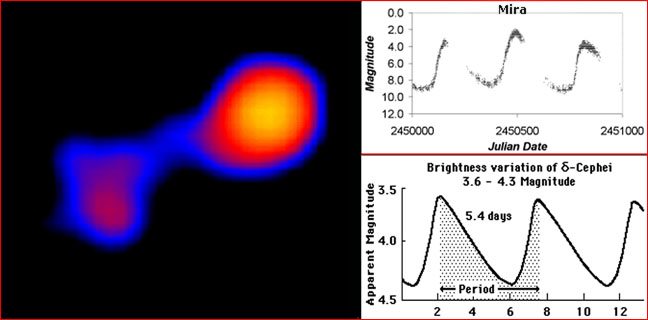
home •
about •
essential guide •
picture of the day •
thunderblogs •
news •
multimedia •
predictions •
products •
get involved •
contact
picture of the day archive subject index
Credit: NASA/M. Karovska et al
Feb 13, 2007
Variable StarsThe brightness fluctuations of “variable stars” have long puzzled astronomers. Perhaps the similarity of their brightness curves to those of lightning is the best indicator of the cause.
What makes a variable star vary? The conventional astronomer and the plasma astronomer will give different answers, because a conventional star and an electrically driven star are not at all alike.
Variable stars, such as Mira (photo above), fit well in the theory of electric stars. Most have a brightness curve similar to that of lightning, with a sudden rise time followed by a slower exponential decay. You can see this curve in the charts of two variables, Mira and of Delta Cephei above.
The brightness curve of Mira (upper diagram) follows the same sudden onset and slow decay as lightning . The star varies over a period of just under a year (the missing part of the brightness curves are the times of the year when the star is not seen at night.) The lower brightness curve is for Delta Cepheus, the flagship star of the Cepheid variables. Cepheid variables have a much shorter period than Mira variables, but 90% of them have the lightning signature of a fast rise and slow decay.
Some variable stars are regular and others are irregular. The irregular ones seem to average power over the bursts. When the bursts are more frequent, the energy per burst is less. This is to be expected from an electric circuit where the trigger level is variable and the power input is constant.
Don Scott, plasma cosmologist and retired professor of electrical engineering, suggests that most, maybe all, variable stars are binaries. Their variability is caused by electric discharge between the two stars.
Scott says: “As I see it, [variable] binaries operate generally as follows: Each of the stars has an electrical capacitance. These two capacitances are permanently connected by a plasma (cloud). This plasma exhibits (as do all plasmas) a nonlinear resistance. If one of the stars charges up to a high enough voltage ... , then the plasma will go into the arc mode and emit brilliant light, perhaps x-rays and gamma-rays. Electrical energy will be transferred from the first capacitor (star) to the other. It doesn't make any difference which star is bigger.
“The "bridge" between the two stars probably doesn't go away. After the arc discharge is over (the voltage difference between the two capacitors is dissipated), the plasma bridge goes back into its normal glow or dark current mode and waits for the next discharge.”
Like a relaxation oscillation circuit, some variable stars reduce their variability and eventually come to equilibrium. We see this happening to the north star, Polaris. Polaris is a binary Cepheid variable whose brightness has increased over the course of the last century, while the level of variability has decreased and the length of time over which it varies has became longer.
The interactions between a star and its companion also apply to close-orbiting planets, as discovered recently in the tau Bootes system. Here the “microvariability” of the star has been correlated to the orbit of a close-orbiting planet. Mainstream astronomers explain it as tidal interactions – the planet pulls the star’s bright atmosphere around with it. But observations show that starspots (sunspots on other stars) and magnetic fields on the star are also related to the planet’s positions. For a plasma cosmologist, that is an indication that electrical interactions should be considered.
Even our own Sun is a variable star (see Wal Thornhill’s link below). It varies over about an eleven-year period known as the sunspot cycle. And, as shown in the 1950’s, that variability is connected to the orbits of the largest planets in the system, Jupiter and Saturn.
For plasma cosmologists, the study of variable stars is an opportunity to better understand the way electrical circuits behave in space.
___________________________________
Please check out Professor Don Scott's new book The Electric Sky.
NOTE TO READERS: Wallace Thornhill, David Talbott, and Anthony Peratt will share the stage with other investigators of planetary catastrophe at the British Society for Interdisciplinary Studies “Conference 2007” August 31-September 2. GET INFO
![]()
home •
thunderblogs •
forum •
picture of the day •
resources •
team •
updates •
contact us
EXECUTIVE EDITORS:
David Talbott, Wallace Thornhill
MANAGING EDITORS:
Steve Smith, Mel Acheson
CONTRIBUTING EDITORS: Michael Armstrong, Dwardu Cardona,
Ev Cochrane,
C.J. Ransom, Don Scott, Rens van der Sluijs, Ian Tresman
WEBMASTER: Brian Talbott
Copyright 2007: thunderbolts.info
